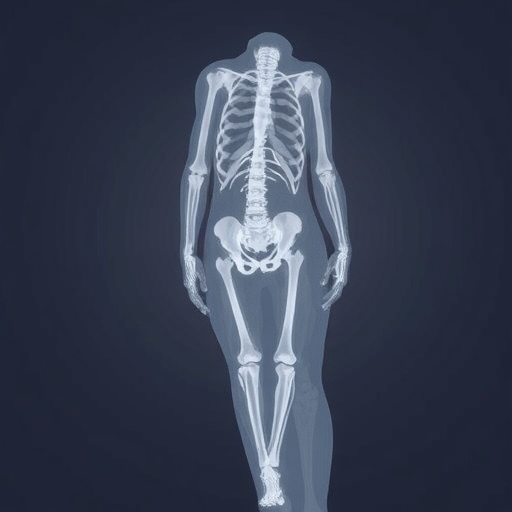In a groundbreaking new study, researchers have embarked on a comprehensive examination of the intricate relationship between circulating plasma proteins and osteoporosis. This research, spearheaded by a team including Wang, Zhou, and Huang, employs advanced methodologies based on Mendelian randomization to elucidate the causal pathways and mediation effects connecting plasma proteins with osteoporosis. The findings featured in the forthcoming 2025 issue of Clinical Proteomics promise to shed new light on the underlying mechanisms of this debilitating skeletal disorder and may pave the way for innovative therapeutic strategies.
Osteoporosis is a global health concern characterized by reduced bone mass and deterioration of bone tissue, leading to an increased risk of fractures. Until now, the multifactorial nature of osteoporosis has posed significant challenges in clearly delineating its causes. This study aims to fill this gap by leveraging the power of two-sample and two-step Mendelian randomization, a method that utilizes genetic variants as instrumental variables. This approach holds the promise of unraveling the complexities behind osteoporosis while minimizing potential confounding factors that often complicate observational studies.
In their rigorous analysis, Wang and colleagues began by identifying a range of circulating plasma proteins previously implicated in bone metabolism and health. Utilizing large-scale genome-wide association study (GWAS) data, the researchers assessed the genetic underpinning of these proteins, providing robust evidence for causal relationships. This step was crucial, as it not only established the relevance of plasma proteins in the context of osteoporosis but also highlighted specific targets that could be further investigated in therapeutic development.
One of the most significant advancements of this study is the methodology involved. By employing a two-sample Mendelian randomization framework, the researchers were able to analyze distinct datasets for exposure and outcome, thus enhancing the reliability of their results. This approach reduces biases often encountered in traditional epidemiological studies, such as reverse causation and residual confounding, thus ensuring that their findings reflect true causal relationships. Such methodological rigor stands out in the current literature on osteoporosis research.
The investigation’s next phase involved detailed statistical mediation analysis aimed at deciphering the pathways through which plasma proteins exert their effects on osteoporosis. This component of the study is particularly exciting, as it reveals not just whether there are causal effects, but how these effects manifest. For instance, by examining various biochemical pathways, the team unearthed crucial insights into the mechanistic relationships between proteins and bone density. This depth of analysis offers a multidimensional perspective on osteoporosis, reinforcing the importance of precision medicine.
Moreover, the study emphasizes the significance of specific proteins that demonstrated a strong association with osteoporotic outcomes. By elucidating how these proteins mediate their impact, the findings underscore potential biomarkers that could be monitored in clinical settings. In doing so, Wang and colleagues provide a foundation for future research that could seamlessly transition from bench to bedside, ultimately aiming for more personalized prevention and treatment strategies for those susceptible to osteoporosis.
As the scientific community grapples with the rising global burden of osteoporosis, the implications of this research are profound. The ability to identify causal relationships opens the door not just for better diagnostic tools but also for targeted therapies that could prevent bone loss before it progresses to osteoporosis. Researchers are now urged to explore these identified proteins further, analyzing possible therapeutic interventions that could modulate their levels or actions to enhance bone health.
The publication of these findings will undoubtedly catalyze further exploration into the role of plasma proteins in skeletal health. Subsequent studies could focus not only on confirmation of the results observed by Wang et al. but also on implementing clinical trials aimed at testing interventions targeting the identified proteins. The path to transforming these scientific insights into reality for millions at risk of osteoporosis may hinge upon collaboration across various disciplines—ranging from genetics to clinical medicine and pharmacology.
Additionally, given the genetic insights provided by this study, there is an exciting opportunity to delve into population-specific analyses. Understanding the variability in genetic predisposition across different ethnicities can foster more inclusive research and potentially lead to tailored interventions that are sensitive to diverse genetic backgrounds. Ensuring that all populations benefit equally from advancements in osteoporosis research is crucial as we move forward.
In conclusion, the work of Wang, Zhou, and Huang marks a significant milestone in osteoporosis research, highlighting the complex interplay between circulating plasma proteins and bone health. Through the innovative application of Mendelian randomization, the study not only paves the way for future research but also lays the groundwork for more effective interventions that could alter the trajectory of osteoporosis management globally. As researchers and clinicians continue to build on these findings, the hope is that we will soon see a shift in how we approach prevention and treatment of this widespread condition.
This study serves as a clarion call for the scientific community to prioritize further exploration of the connections uncovered. With collaboration at the forefront, the vision of enhancing bone health through precision medicine may soon become a tangible reality for many individuals worldwide. The commitment to unraveling the mysteries of osteoporosis has never been stronger, and the future of care for this condition is on a promising horizon.
Subject of Research: Circulating plasma proteins and their causal effects on osteoporosis.
Article Title: Causal effects and mediation pathways of circulating plasma proteins on osteoporosis: a two-sample and two-step Mendelian randomization study.
Article References:
Wang, H., Zhou, W., Huang, Y. et al. Causal effects and mediation pathways of circulating plasma proteins on osteoporosis: a two-sample and two-step Mendelian randomization study.
Clin Proteom 22, 38 (2025). https://doi.org/10.1186/s12014-025-09558-0
Image Credits: AI Generated
DOI:
Keywords: Osteoporosis, plasma proteins, Mendelian randomization, causal effects, mediation pathways, skeletal health.




